Weekend Herb Blogging
Lemon Grass aka Serai aka Sereh
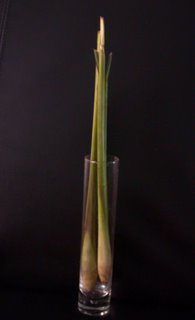
I love the smell of lemon grass. It somehow evokes images of hot summer days, fresh field flowers, cool water trickling in between your toes and gentle, balmy kisses from a passing breeze.
Just the act of tearing off the papery outer skin of the lemon grass will leave the fragrance of spicy lemon mixed with lingering grass on your hands. Forget the expensive perfumes! Gimme the lemon grass!
Lemon grass used to be common only to Asia but nowadays it can be found just about anywhere. In its unharvested form, it is a tall grass with sharp edged leaves. The bulbous pale base is the best part of the lemon grass and is the part that we use the most for our curries and other dishes.
 When you use lemon grass, you have to discard the harder, papery outer leaves till you strip it down to the more tender section. Then slice off the root. The strange thing is that when you slice it into discs across the grain, it looks like lollipop with its pale green, purplish-pink and white circles. I love the look and when there are young kids around, they get a real kick out of the pretty little discs.
When you use lemon grass, you have to discard the harder, papery outer leaves till you strip it down to the more tender section. Then slice off the root. The strange thing is that when you slice it into discs across the grain, it looks like lollipop with its pale green, purplish-pink and white circles. I love the look and when there are young kids around, they get a real kick out of the pretty little discs.
You can get lemon grass fresh, dried or powdered nowadays but I just love fresh lemon grass. Slim, elegant, understated yet resilient, this aromatic herb lingers seductively on your senses. I've used it not only to flavour my food but also as a visual centrepiece. Just a couple of stalks in a tall glass or mixed in with some flowers and suddenly you have scented ikebana. Even better, lemon grass is a natural insect repellent so you save a bundle and the environment by not using Ridsect!
I've drank lemon grass infused tea before I go to bed on the advice from an Indian friend's mum when I complained that I was having problems sleeping. Take one stalk of lemon grass and bruise it slightly with your pestle or a rolling pin. Brew some mild tea with the lemon grass and you have a lovely and comforting concoction to take you softly into sleep's arms.
Lemon grass also has quite a number of medicinal properties. It is supposed to help lessen mucus, alleviate fevers, cramps and is a stress reliever. These days, you see it in every aromatherapy shop and it can be found in oils, ointments, soaps, perfumes and even cosmetics.
Galangal aka Lengkuas aka Laos
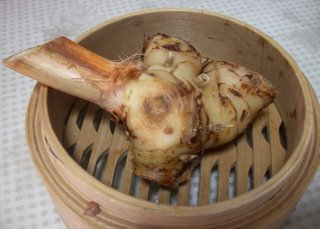
Try saying that to some German at the Kleinmarkthalle. You'll never get what you want. I've always wondered what the English name is and I've heard it called blue ginger before but someone else told me that was incorrect so ...
Galangal is a root and is from the ginger family. It is easy to mistake the normal ginger for galangal but the skin is way coarser and ridged with woody fibres sprouting rudely from it. Also, the smell is quite distinctive and is more subtle than the ginger. Peel the skin and you have a pale yellow flesh that is quite fibrous. Very much an Indonesian herb as it is used in many dishes there, the lesser galangal is also found in China, India and many other Southeast Asian countries.
You can slice, dice or pound the galangal to flavour your food. Like the ginger, galangal works very well with fish and other seafood as it tones down the overbearing "fishiness" of the dish. Again, it comes fresh or powdered and in Vietnam, Thailand and Laos, you can find it in bottles of powder labelled as Laos. Why, I have no idea but I remember being terribly confused when I asked for galangal at the Asian markets and was directed to Laos.
Apparently, the galangal is so amazing that even the Arabs used it to stimulate their horses. No indication on how they did that but I hope it was not painful. Yikes. But there might be some logic to this usage as galangal is a stimulant and its medicinal properties includes the ability to alleviate nausea, flatulence and rheumatism. It is antibacterial in nature so it has become quite popular in aromatherapy and homeopathic medicine. In fact, I have seen it used in ayurvedic practice for the treatment of halitosis and body odour. And also as a really yummy smelling body scrub at some spas.
I've read that galangal has been used as an aphrodisiac in Europe and Asia for centuries. I'm not sure about that but I sure hope they brush their teeth after eating galangal ... because it's quite pungent and spicy and unless the other party likes you smelling like an Indian restaurant ... well ... But I think this could be attributed to the fact that galangal is a "heaty" herb so you know what they say - "Baby you can light my fire ...".
Ladies Fingers aka Okra
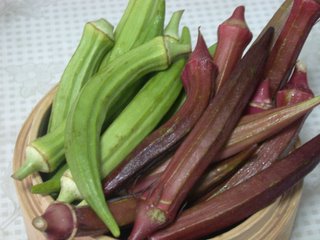
I love ladies fingers. I mean I just luuuuuurrrrve ladies fingers. It is definitely one of my favourite vegetables and when I make curry, I have to have it in the curry. Sometimes I just make ladies fingers curry or sambal and have it with plain white rice and I am a happy camper.
My love affair with ladies fingers goes so far into the recesses of my memory bank that I cannot even remember the first blushing meeting between us. But I know we had a date during art class. When I sliced into a ladies finger to use it to make stamps. The shapes were so cool I went around stamping anything that stood still. My family was not amused when they found the walls sporting ladies fingers stamps. I was not amused when I had to stand in a corner without dinner.
I read that the ladies finger is African in origin. How it became such a staple in Indian and Malay cuisine is a mystery to me but hey, I will not look a gift horse in the mouth. I think it is very possible that the Arabs adopted the ladies finger from the Africans and then brought it into India. And from there, it travelled down to the rest of Asia. In the US, it is known as okra and I was thrilled when I realised how beloved it was in the South. My introduction to gumbo was a happy, happy day. I love gumbo. I can eat it every day! And I make quite a mean gumbo too.
But I suppose the South's adoption of okra is understandable since it is from the hibiscus and cotton family. But if you had told me when I was a little girl terrorising the walls with ladies fingers stamps that I would be finding a bunch of Americans drooling over okra like me, I would have laughed into my okra. What's interesting (and confusing) is that okra is also called gumbo. Apparently gumbo is the Swahili name for okra. Woah ... now who's on first?
Anyway, ladies fingers can apparently be eaten raw. I've never tried that but I would think the sticky, filmy fluid inside the okra will not be able to transform into a glossy film that coats your tongue with the flavours of the okra when it is raw. Also, I vaguely remember my grandfather telling me that it is not safe to eat okra raw so I have never dared to try it as such.
Ladies fingers can also be dried and apparently, they taste exactly the same as the fresh ones when you cook them in stews or gumbos. In Asia, I do not think they like ladies fingers in any form except fresh as all the dishes I have ever tasted have always featured fresh ladies fingers.
I've read that the seeds of the ladies fingers can yield an edible oil that is as good as any cooking oil that we get commercially. Interesting, I wouldn't mind trying that. I wonder where I can get a sample? Also, you can roast and ground the ripe seeds of the ladies fingers and this can be used as a substitute for coffee. In Turkey, they even use the leaves in preparing a tincture to soothe or reduce inflammation. How cool is that? I am telling you I am loving my ladies fingers more and more!
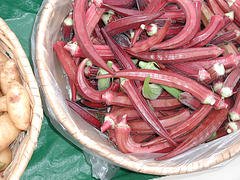 But I had never seen a red okra before. So when I was at the wet market doing my shopping, imagine my surprise when the vegetable seller directed me to this purplish- and pinkish-red ladies fingers. I blinked at him and went, "What's this?" The old man was terribly tickled at my wide-eyed examination of this most unusual vegetable. I gasped and fussed over it such that his wife came over and we discussed the merits of red versus green okra. I even asked her if it tasted the same and she assured me that there was really no difference. But she could not tell me why it was red!
But I had never seen a red okra before. So when I was at the wet market doing my shopping, imagine my surprise when the vegetable seller directed me to this purplish- and pinkish-red ladies fingers. I blinked at him and went, "What's this?" The old man was terribly tickled at my wide-eyed examination of this most unusual vegetable. I gasped and fussed over it such that his wife came over and we discussed the merits of red versus green okra. I even asked her if it tasted the same and she assured me that there was really no difference. But she could not tell me why it was red! Fascinated, I bought a bundle but just to be careful I went to another stall and bought a bunch of the normal green ladies fingers. I wanted to test out the difference between the two when I got home. I boiled a single green and red okra as an experiment. To my intense disappointment, the red okra lost all its blustery redness under the hot water. It turned a pale shade of green. Severely sulky now, I tried a piece of it. It tasted exactly the same as the green okra. Bugger.
I was not appeased so I did an Internet search and found some information. The data is split. Some claimed that red okra is more flavourful and tender. Not so to my experiment. Others alleged that it makes so difference, which I concur with. Oh well ... at least they looked pretty on my pantry.
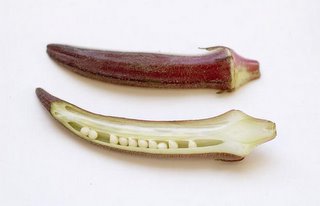
Perhaps the lesson here is that it does not matter what colour it is. It's what's inside that is important. 'Cos it all tastes the same in the end it.
I just have to share one of my quick and easy ladies fingers recipe here because it is just so good and satisfying, it's ridiculous.
Ladies Fingers Sambal
A bunch of ladies fingers - cut in half if they are too long
Sambal paste
Salt
Sugar
Oil
2 cloves of garlic, sliced
1. Saute the garlic in the oil till fragrant but not browned
2. Add the ladies fingers and saute with the sambal paste
3. Season with salt and a pinch of sugar
4. Add a tbsp of water and continue to saute till the ladies finger is cooked but still crunchy
5. Serve hot with plain rice
You can also add some prawns to this dish and you basically just add them in with the ladies fingers. This is such an easy and yummy dish that every time I make it, I have to fight for my portion. There is just no respect for the chef!
Curry Leaves
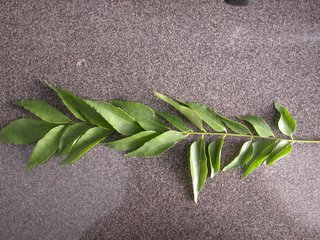 The Indian spice seller was such as sweetheart that he gave me two sprigs of curry leaves on the house. I really like going to the wet markets because you get a level of interaction with the stall keepers that you just do not get in a supermarket. They are usually sweet, helpful and are inclined to give you lots of freebies.
The Indian spice seller was such as sweetheart that he gave me two sprigs of curry leaves on the house. I really like going to the wet markets because you get a level of interaction with the stall keepers that you just do not get in a supermarket. They are usually sweet, helpful and are inclined to give you lots of freebies.
For some reason, most wet market stall keepers seem to like me. Maybe it's because I am always so curious about everything and would ask them questions about what that odd vegetables is, how do you cook this fish or what is the best cut for XXX dish. Also, I think it's because I look the way I do so they never expect me to be able to cook. The fish mongers are the first section I have to go through and a couple of the cheeky buggers would always yell out "Lang loy" to me every time I go to the wet market. It's embarrassing as it means "pretty girl" in Cantonese and I always wonder if it is a satorial commentary at my state of no make-up and extremely scruffy clothes when I stumble there on weekend mornings.
After that is the vegetable stalls and almost all of the stall keepers are as old as time. They would smile beatifically at me and ask me what I was intending to cook that day. And then they will break into a discussion about recipes and cooking techniques and marvel that a "young girl" like me can actually and does cook on a fairly regular basis.
The meat sellers are last in the wet market. But strangely, this wet market sells mostly pork or chicken. And there is only one stall that sells mutton and of course it is run by a young Indian bloke. He's very nice and we usually have long, involved conversations about recipes and food. And he would usually reserve a couple of bones on the house for me for making stocks. Very nice of him. In fact, they're all lovely people and I'm always happy to go marketing so I can have a wee chat with them.
Anyway, back to the curry leaves. Most of the time, you get them dried but frankly they are kind of a waste of time dried as you can hardly get any fragrance from them dried. Lucky for me, I have nice Indian spice sellers who give me fresh ones on the house. Curry leaves are as important to curries as bay leaves are to stews. The leaves are fairly smell and very glossy looking. They are so symmetrical that there is something very comforting about their conformity. The dark green sheen of the leaves bely the delicate feel of the leaves and the fragrance is wonderfully spicy and musky, evoking images of the hot spices seen through diaphanous veils.
I've just expended all my passion on drooling over my ladies fingers so I think I will keep the rest of the spices for the next Weekend Herb Blogging. Now I think I am going to go get more ladies fingers to add to my leftover Mutton Curry. Major drool.
Categories - VeggieMight

5 Comments:
I love learning about these interesting ingredients. Great post.
All very interesting! I like okra, alot. I have to find some lemongrass! Thanks for a wonderful post.
Best,
Paz
Hey there Stephanie,
just made your Brinjal Sambal (with prawns!) tonight based on your recipe, and it eorked very well - and I'm having it for dinner again tomorrow night - along with my fish cooked in galangal,chili, onion, garlic, lemon grass, turmeric and coconut milk - my mother called it Ikan Mouli - not sure of the spelling, but it's been a Wilson recipe ever since we lived in Taiping (early 60's) - anyway - your recipe is a hit! Thanks!!! Graeme
Graeme baby! The Ikan Mouli sounds absolutely yummy! Droool. Glad you liked my recipe. I like easy, fast and tasty. Wait ... does that work for men too? LOL. EEUUWWW.
My child loves okra so I bought some red okra seeds online, hoping she would think the color cool. I never was much of a fan of okra, until now! You wouldn't imagine the yield from one plant! For those who don't like the slimy texture, which binds to cholesterol an eliminates it apparently, just cut it up and add it to any casserole recipe. It's great. Also great in omelettes.
Bob
Post a Comment
<< Home